Press Releases
Euroseas Ltd. Reports Results for the Six-Month Period and Quarter Ended June 30, 2017
Maroussi, Athens, Greece - August 9, 2017 - Euroseas Ltd. (NASDAQ: ESEA), an owner and operator of drybulk and container carrier vessels and provider of seaborne transportation for drybulk and containerized cargoes, announced today its results for the three and six month period ended June 30, 2017.
Second Quarter 2017 Highlights:
• Total net revenues of $10.0 million. Net loss of $1.0 million; net loss attributable to common shareholders (after a $0.4 million of dividend on Series B Preferred Shares) of $1.5 million or $0.13 loss per share basic and diluted. Adjusted net loss attributable to common shareholders1 remained unchanged, compared to net loss attributable to common shareholders, at $0.13 per share.
• Adjusted EBITDA1 was $2.0 million.
• An average of 13.1 vessels were owned and operated during the second quarter of 2017 earning an average time charter equivalent rate of $8,191 per day.
• The Company declared its fourteenth dividend of $0.4 million on its Series B Preferred Shares; the dividend was paid in-kind by issuing additional Series B Preferred Shares.
First Quarter 2017 Highlights:
• Total net revenues of $18.3 million. Net loss of $3.2 million; net loss attributable to common shareholders (after a $0.9 million of dividend on Series B Preferred Shares) of $4.1 million or $0.37 loss per share basic and diluted. Adjusted net loss per share attributable to common shareholders1 for the period was $0.42.
• Adjusted EBITDA1 was $2.2 million
• An average of 13.3 vessels were owned and operated during the first half of 2017 earning an average time charter equivalent rate of $7,654 per day.
1Adjusted EBITDA, Adjusted net loss and Adjusted loss per share are not recognized measurements under GAAP. Refer to a subsequent section of the Press Release for the definitions and reconciliation of these measurements to the most directly comparable financial measures calculated and presented in accordance with U.S. GAAP.
Aristides Pittas, Chairman and CEO of Euroseas commented: "During the second quarter of 2017, both the drybulk and containership markets continued their recovery. Although charter rates peaked in early May and have softened since, they remain at levels noticeably higher than their respective periods of last year. Expectations for continued economic growth across many developed and developing countries and low levels of orderbook for both sectors support our guarded optimism that charter rates will further improve in the latter part of the year and in 2018. Thus, we consider the current charter rate levels appropriate for short and selected medium term charters, a strategy that affords us the flexibility to take advantage of any improvement in charter rates.
"At the same time, we are trying to exploit any opportunities to acquire new vessels in accretive transactions like our recent acquisition of M/V EM Astoria. We continue to believe that a company like Euroseas with access to the public markets and a cost-effective operating structure provides an ideal consolidation platform for drybulk and containership vessels and we are exploring such opportunities."
Tasos Aslidis, Chief Financial Officer of Euroseas commented: "The results of the second quarter of 2017 reflect the improving levels of the containership and drybulk markets compared to the same period of 2016.
"Adjusted EBITDA during the second quarter of 2017 was $2.0 million versus $(0.9) million in the second quarter of last year. During the second quarter of 2017, we repaid $1.5 million of debt earlier than scheduled and as a result one of our vessels, M/V Joanna, is unencumbered. As of June 30, 2017, our outstanding debt (excluding the unamortized loan fees) was $62.9 million versus restricted and unrestricted cash of $13.7 million. As of the same date, our scheduled debt repayments over the next 12 months amounted to about $11.4 million (excluding the unamortized loan fees).
"Total daily vessel operating expenses, including management fees, general and administrative expenses but excluding drydocking costs, averaged $5,984 per vessel per day during the second quarter of 2017 as compared to $6,065 per vessel per day for the same quarter of last year, and $5,835 per vessel per day for the first half of 2017 as compared to $6,097 per vessel per day for the same period of 2016, reflecting a 1.3% and 4.3% decline, respectively. As always, we want to emphasize that cost control remains a key component of our strategy."
Second Quarter 2017 Results:
For the second quarter of 2017, the Company reported total net revenues of $10.0 million representing a 36.4% increase over total net revenues of $7.3 million during the second quarter of 2016. The Company reported net loss for the period of $1.0 million and a net loss attributable to common shareholders of $1.5 million, as compared to a net loss of $19.2 million and a net loss attributable to common shareholders of $19.6 million, respectively, for the same period of 2016. The results for the second quarter of 2016 include a $0.01 million gain on sale of a vessel, a $1.4 million loss on termination of new building contract and a $14.0 million impairment charge on investment in joint venture none of which were incurred in the second quarter of 2017. Drydocking expenses amounted to $0.05 million during the second quarter of the year 2017 as a vessel underwent an in-water survey compared to one vessel that underwent drydocking during the second quarter of 2016 for a total amount of $1.2 million. Depreciation expenses for the second quarter of 2017 remained unchanged at $2.2 million compared to the same period of 2016.
Interest and other financing costs for the second quarter of 2017 amounted to $0.86 million compared to $0.54 million for the same period of 2016. Interest during the second quarter of 2017 was higher due to higher debt during the period as compared to the same period of last year during which interest was also lower due to the recognition of imputed interest for the vessels then under construction. In the second quarter of 2017, there was no equity loss and investment in joint venture as compared to equity loss of $0.57 million and impairment of investment in joint venture of $14.0 million for the three months ended June 30, 2016, as in June 2016, the Company concluded that its equity investment in Euromar and the invested portion of its investment in preferred units of Euromar were totally impaired and hence the Company also ceased recognising income on the preferred units.
On average, 13.1 vessels were owned and operated during the second quarter of 2017 earning an average time charter equivalent rate of $8,191 per day compared to 11.4 vessels in the same period of 2016 earning on average $7,213 per day.
Adjusted EBITDA for the second quarter of 2017 was $2.0 million compared to $(0.9) million achieved during the second quarter of 2016. Please see below for Adjusted EBITDA reconciliation to net loss and cash flow provided by operating activities.
Basic and diluted loss per share attributable to common shareholders for the second quarter of 2017 was $0.13 calculated on 11,061,612 basic and diluted weighted average number of shares outstanding, compared to basic and diluted loss per share of $2.42 for the second quarter of 2016, calculated on 8,104,860 basic and diluted weighted average number of shares outstanding.
Excluding the effect on the loss attributable to common shareholders for the quarter of the unrealized loss on derivatives and the realized gain / loss on derivatives, the loss on termination of a newbuilding contract and the impairment of investment in joint venture, the adjusted net loss per share attributable to common shareholders for the quarter ended June 30, 2017 would have remained unchanged at $0.13 per share basic and diluted compared to adjusted net loss of $0.51 per share basic and diluted for the quarter ended June 30, 2016. Usually, security analysts do not include the above items in their published estimates of earnings per share.
First Half 2017 Results:
For the first half of 2017, the Company reported total net revenues of $18.3 million representing a 31.8% increase over total net revenues of $13.9 million during the first half of 2016, as a result of the increased average number of vessels and the increase in the average time charter equivalent rate our vessels earned. The Company reported a net loss for the period of $3.2 million and a net loss attributable to common shareholders of $4.1 million, as compared to net loss of $22.0 million and $22.9 million respectively, for the first half of 2016. The results for the first half of 2017 include a $0.5 million gain on sale of a vessel, as compared to a $0.2 million unrealized loss on derivatives, a $0.1 million realized loss on derivatives, a $0.01 million gain on sale of a vessel, a $1.4 million loss on termination of a new building contract and a $14.0 million impairment charge on investment in joint venture for the same period of 2016. Depreciation expenses for the first half of 2017 were $4.3 million compared to $4.4 million during the same period of 2016.
Interest and other financing costs for the first half of 2017 amounted to $1.63 million compared to $0.92 million for the same period of 2016. This increase is due to the increased amount of debt in the current period compared to the same period of 2016 and the recognition of imputed interest in the first half of 2016 for the vessels then under construction that reduced the interest for the period.
On average, 13.3 vessels were owned and operated during the first half of 2017 earning an average time charter equivalent rate of $7,654 per day compared to 11.5 vessels in the same period of 2016 earning on average $6,702 per day.
Adjusted EBITDA for the first half of 2017 was $2.2 million compared to $(1.0) million achieved during the first half of 2016. Please see below for Adjusted EBITDA reconciliation to net loss and cash flow provided by operating activities.
Basic and diluted loss per share attributable to common shareholders for the first half of 2017 was $0.37 , calculated on 11,030,754 basic and diluted weighted average number of shares outstanding compared to basic and diluted loss per share of $2.82 for the first half of 2016, calculated on 8,104,860 basic and diluted weighted average number of shares outstanding.
Excluding the effect on the loss attributable to common shareholders for the first half of the year of the unrealized loss on derivatives, realized gain/loss on derivatives, loss on termination of newbuilding contract, impairment of investment in joint venture and the gain on sale of vessel, the adjusted net loss per share attributable to common shareholders for the six-month period ended June 30, 2017 would have been $0.42 compared to loss of $0.89 per share basic and diluted for the same period in 2016. Usually, security analysts do not include the above items in their published estimates of earnings per share.
Fleet Profile:
The Euroseas Ltd. fleet profile is as follows:
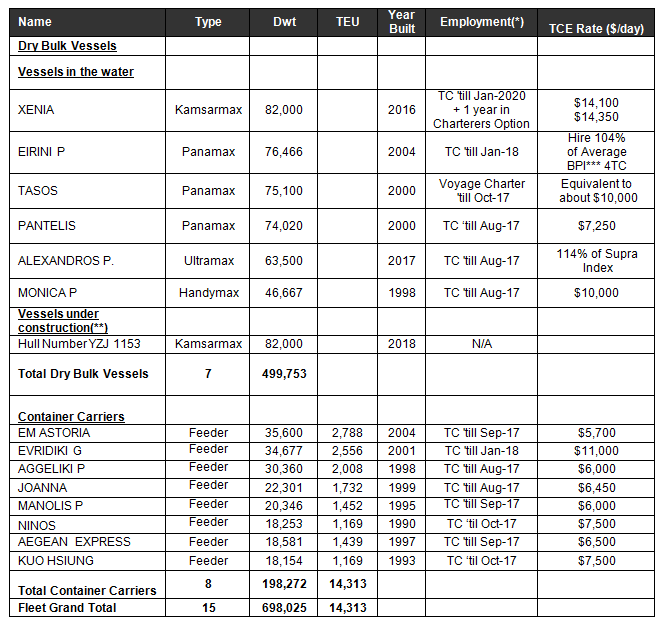 Note:
Note: (*) Represents the earliest redelivery date
(**) Hull Number YZJ 1153 is due to be delivered in the second quarter of 2018.
(***) BPI stands for the Baltic Panamax Index; the average BPI 4TC is an index based on four time charter routes.
Summary Fleet Data:
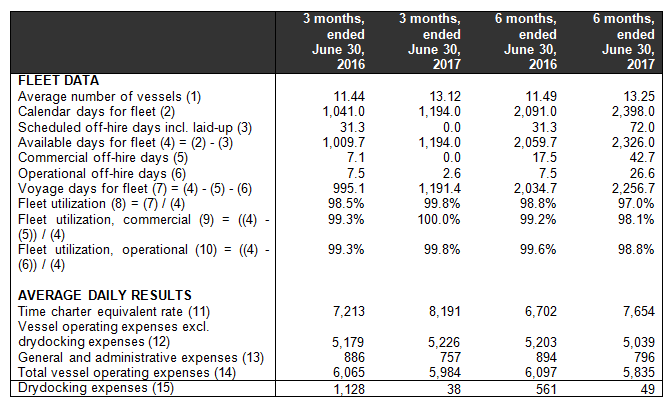
(1)Average number of vessels is the number of vessels that constituted the Company's fleet for the relevant period, as measured by the sum of the number of calendar days each vessel was a part of the Company's fleet during the period divided by the number of calendar days in that period.
(2) Calendar days. We define calendar days as the total number of days in a period during which each vessel in our fleet was in our possession including off-hire days associated with major repairs, drydockings or special or intermediate surveys or days of vessels in lay-up. Calendar days are an indicator of the size of our fleet over a period and affect both the amount of revenues and the amount of expenses that we record during that period.
(3) The scheduled off-hire days including vessels laid-up are days associated with scheduled repairs, drydockings or special or intermediate surveys or days of vessels in lay-up.
(4) Available days. We define available days as the total number of days in a period during which each vessel in our fleet was in our possession net of scheduled off-hire days. We use available days to measure the number of days in a period during which vessels were available to generate revenues.
(5) Commercial off-hire days. We define commercial off-hire days as days a vessel is idle without employment (this definition has been revised starting this period to exclude from commercial offhire days, days the vessel is sailing for repositioning purposes; previous periods' commercial offihire has been adjusted accordingly if necessary).
(6) Operational off-hire days. We define operational off-hire days as days associated with unscheduled repairs or other off-hire time related to the operation of the vessels.
(7) Voyage days. We define voyage days as the total number of days in a period during which each vessel in our fleet was in our possession net of commercial and operational off-hire days. We use voyage days to measure the number of days in a period during which vessels actually generate revenues or are sailing for repositioning purposes.
(8) Fleet utilization. We calculate fleet utilization by dividing the number of our voyage days during a period by the number of our available days during that period. We use fleet utilization to measure a company's efficiency in finding suitable employment for its vessels and minimizing the amount of days that its vessels are off-hire for reasons such as unscheduled repairs or days waiting to find employment.
(9) Fleet utilization, commercial. We calculate commercial fleet utilization by dividing our available days net of commercial off-hire days during a period by our available days during that period.
(10) Fleet utilization, operational. We calculate operational fleet utilization by dividing our available days net of operational off-hire days during a period by our available days during that period.
(11) Time charter equivalent, or TCE, is a measure of the average daily revenue performance of a vessel on a per voyage basis. Our method of calculating TCE is determined by dividing revenue generated from voyage charters net of voyage expenses by voyage days for the relevant time period. Voyage expenses primarily consist of port, canal and fuel costs that are unique to a particular voyage, which would otherwise be paid by the charterer under a time charter contract. TCE is a standard shipping industry performance measure used primarily to compare period-to-period changes in a shipping company's performance despite changes in the mix of charter types (i.e., spot voyage charters, time charters and bareboat charters) under which the vessels may be employed between the periods.
(12) Daily vessel operating expenses, which includes crew costs, provisions, deck and engine stores, lubricating oil, insurance, maintenance and repairs and management fees are calculated by dividing vessel operating expenses by fleet calendar days for the relevant time period. Drydocking expenses are reported separately.
(13) Daily general and administrative expense is calculated by dividing general and administrative expense by fleet calendar days for the relevant time period.
(14) Total vessel operating expenses, or TVOE, is a measure of our total expenses associated with operating our vessels. TVOE is the sum of vessel operating expenses excluding drydocking expenses and general and administrative expenses. Daily TVOE is calculated by dividing TVOE by fleet calendar days for the relevant time period.
(15) Drydocking expenses, which include expenses during drydockings that would have been capitalized and amortized under the deferral method divided by the fleet calendar days for the relevant period. Drydocking expenses could vary substantially from period to period depending on how many vessels underwent drydocking during the period.
Conference Call and Webcast:
Later today, August 9, 2017 at 10:00 a.m. Eastern Time, the Company's management will host a conference call and webcast to discuss the results.
Conference Call details:
Participants should dial into the call 10 minutes before the scheduled time using the following numbers: 1 (866) 819-7111 (from the US), 0(800) 953-0329 (from the UK) or (+44) (0) 1452 542 301 (from outside the US). Please quote "Euroseas."
A replay of the conference call will be available until August 16, 2017. The United States replay number is 1(866) 247-4222; from the UK 0(800) 953-1533; the standard international replay number is (+44) (0) 1452 550 000 and the access code required for the replay is: 6973591#.
Audio webcast - Slides Presentation:
There will be a live and then archived audio webcast of the conference call, via the internet through the Euroseas website (www.euroseas.gr). Participants to the live webcast should register on the website approximately 10 minutes prior to the start of the webcast. A slide presentation on the Second Quarter 2017 results in PDF format will also be available 10 minutes prior to the conference call and webcast accessible on the company's website (www.euroseas.gr) on the webcast page. Participants to the webcast can download the PDF presentation.
Unaudited Consolidated Condensed Statements of Operations
(All amounts expressed in U.S. Dollars - except number of shares)
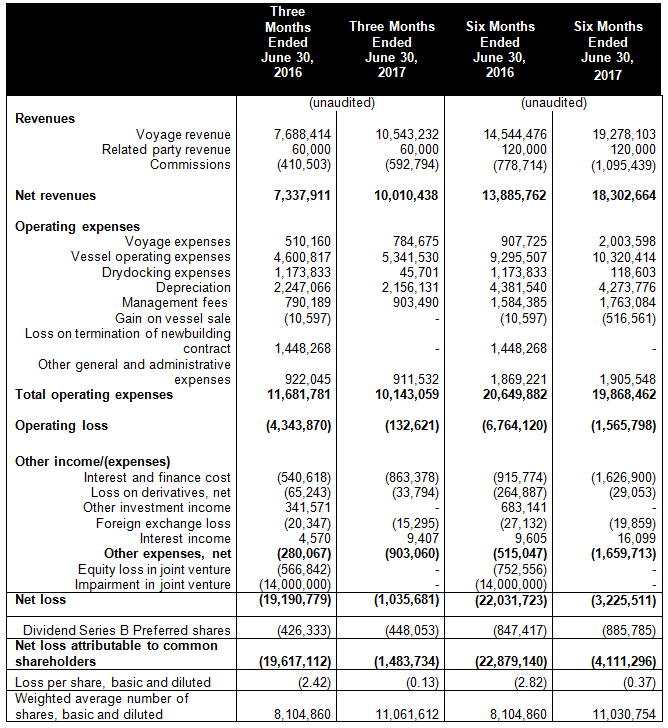
Unaudited Consolidated Condensed Balance Sheets
(All amounts expressed in U.S. Dollars - except number of shares)
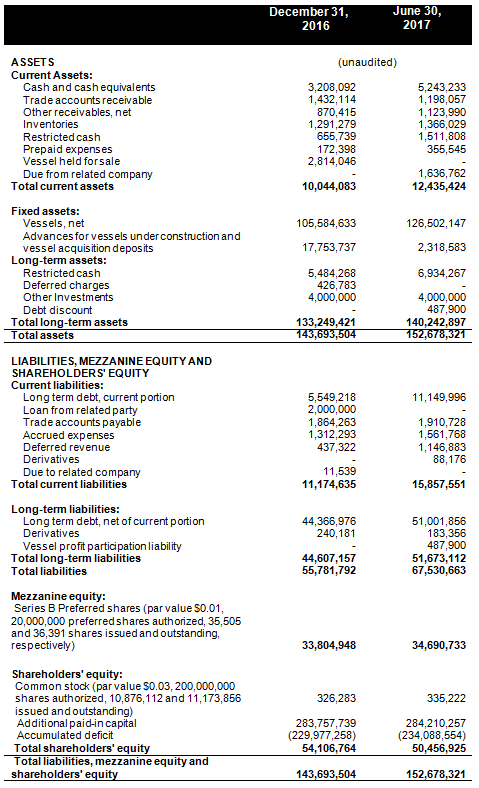
Unaudited Consolidated Condensed Statements of Cash Flows
(All amounts expressed in U.S. Dollars)
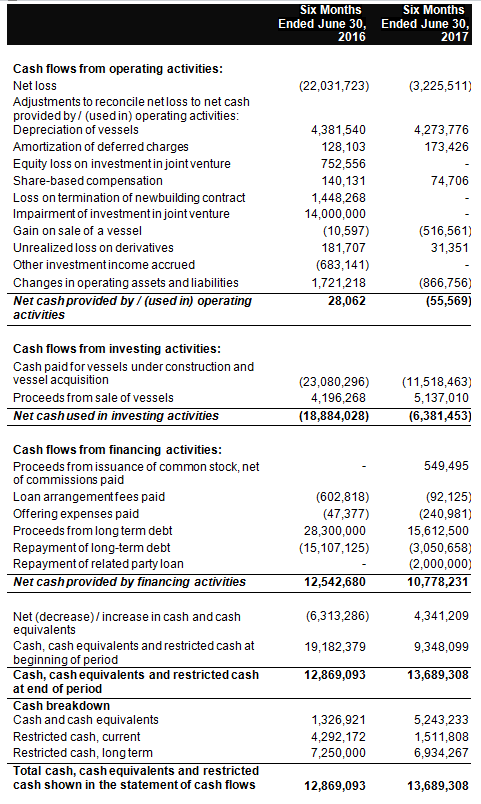
Reconciliation of Adjusted EBITDA to
Net loss and Cash Flow Provided By (Used In) Operating Activities
(All amounts expressed in U.S. Dollars)
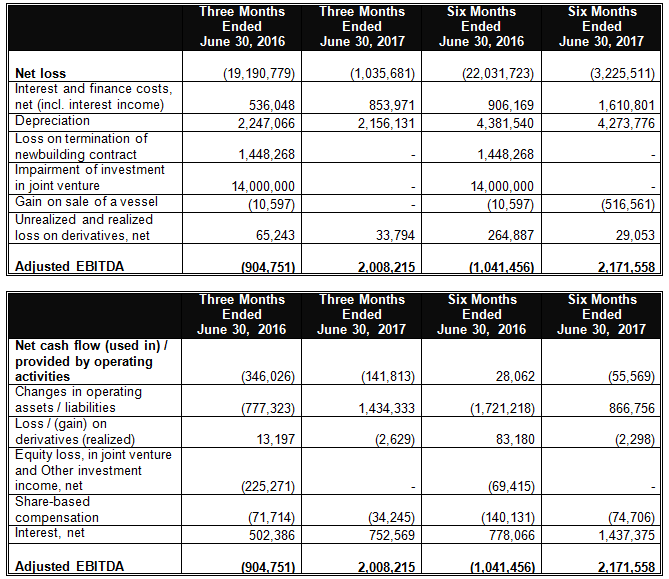
Adjusted EBITDA Reconciliation:
Euroseas Ltd. considers Adjusted EBITDA to represent net loss before interest, income taxes, depreciation, gain / loss in derivatives, loss on termination of newbuilding contract, impairment of investment in joint venture and gain on sale of vessel. Euroseas also computes Adjusted EBITDA by adding the net cash flow provided by / (used in) operating activities, the changes in operating assets / liabilities of the period, the realized loss or (gain) on derivatives, the equity loss in joint venture and other investment income, the share based compensation of the period and the net interest of the period. Adjusted EBITDA does not represent and should not be considered as an alternative to net income /(loss) or cash flow from operations, as determined by United States generally accepted accounting principles, or U.S. GAAP. Adjusted EBITDA is included herein because it is a basis upon which the Company assesses its financial performance and liquidity position and because the Company believes that it presents useful information to investors regarding a company's ability to service and/or incur indebtedness. The Company's definition of Adjusted EBITDA may not be the same as that used by other companies in the shipping or other industries.
Reconciliation of Net loss to Adjusted net loss
(All amounts expressed in U.S. Dollars - except share data and number of shares)
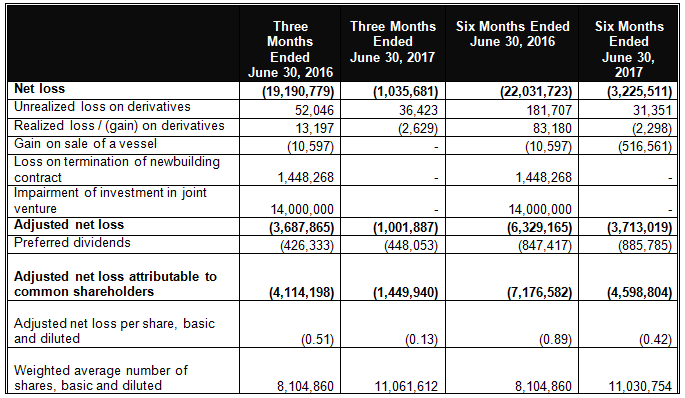
"Adjusted net loss" and "Adjusted net loss per share" Reconciliation: Euroseas Ltd. considers "Adjusted net loss" to represent net loss before gain / loss on derivatives, gain on sale of vessel, loss on termination of newbuilding contract and impairment of investment in joint venture. "Adjusted net loss" and "Adjusted net loss per share" is included herein because we believe it assists our management and investors by increasing the comparability of the Company's fundamental performance from period to period by excluding the potentially disparate effects between periods of gain / loss on derivatives, loss on termination of newbuilding contract, impairment of investment in joint venture and gain on sale of vessel, which items may significantly affect results of operations between periods.
"Adjusted Net loss" and "Adjusted net loss per share" do not represent and should not be considered as an alternative to net loss or loss per share, as determined by U.S. GAAP, The Company's definition of "Adjusted net loss" and "Adjusted net loss per share" may not be the same as that used by other companies in the shipping or other industries.
About Euroseas Ltd.
Euroseas Ltd. was formed on May 5, 2005 under the laws of the Republic of the Marshall Islands to consolidate the ship owning interests of the Pittas family of Athens, Greece, which has been in the shipping business over the past 140 years. Euroseas trades on the NASDAQ Capital Market under the ticker ESEA.
Euroseas operates in the dry cargo, drybulk and container shipping markets. Euroseas' operations are managed by Eurobulk Ltd., an ISO 9001:2008 and ISO 14001:2004 certified affiliated ship management company and Eurobulk (Far East) Ltd. Inc., which are responsible for the day-to-day commercial and technical management and operations of the vessels. Euroseas employs its vessels on spot and period charters and through pool arrangements.
The Company has a fleet of 14 vessels, including 3 Panamax drybulk carriers, 1 Handymax drybulk carrier, 1 Kamsarmax drybulk carrier, 1 Ultramax drybulk carrier and 8 Feeder containerships. Euroseas 6 drybulk carriers have a total cargo capacity of 417,753 dwt and its 8 containerships have a cargo capacity of 14,313 teu. The Company has also signed a contract for the construction of one extra Kamsarmax (82,000 dwt) fuel efficient drybulk carrier. Including the new-building vessel, the total cargo capacity of the Company's drybulk vessels will be 499,753 dwt.
Forward Looking Statement
This press release contains forward-looking statements (as defined in Section 27A of the Securities Act of 1933, as amended, and Section 21E of the Securities Exchange Act of 1934, as amended) concerning future events and the Company's growth strategy and measures to implement such strategy; including expected vessel acquisitions and entering into further time charters. Words such as "expects," "intends," "plans," "believes," "anticipates," "hopes," "estimates," and variations of such words and similar expressions are intended to identify forward-looking statements. Although the Company believes that the expectations reflected in such forward-looking statements are reasonable, no assurance can be given that such expectations will prove to have been correct. These statements involve known and unknown risks and are based upon a number of assumptions and estimates that are inherently subject to significant uncertainties and contingencies, many of which are beyond the control of the Company. Actual results may differ materially from those expressed or implied by such forward-looking statements. Factors that could cause actual results to differ materially include, but are not limited to changes in the demand for dry bulk vessels and container ships, competitive factors in the market in which the Company operates; risks associated with operations outside the United States; and other factors listed from time to time in the Company's filings with the Securities and Exchange Commission. The Company expressly disclaims any obligations or undertaking to release publicly any updates or revisions to any forward-looking statements contained herein to reflect any change in the Company's expectations with respect thereto or any change in events, conditions or circumstances on which any statement is based.
Visit our website www.euroseas.gr
Company Contact
Tasos Aslidis
Chief Financial Officer
Euroseas Ltd.
11 Canterbury Lane,
Watchung, NJ 07069
Tel. (908) 301-9091
E-mail: aha@euroseas.gr
Investor Relations / Financial Media
Nicolas Bornozis
President
Capital Link, Inc.
230 Park Avenue, Suite 1536
New York, NY 10169
Tel. (212) 661-7566
E-mail: nbornozis@capitallink.com
